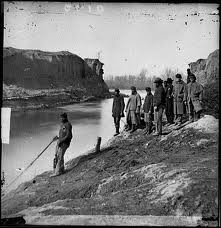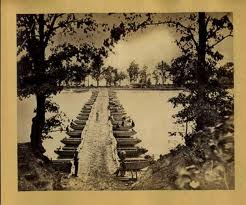
William Littlefield enlisted 15 Aug 1861 at age 33 as a private in Company D, Third Infantry. At the time of his enlistment he resided in Newmarket, employed as a carder in the cotton mills. He mustered in 23 Aug 1861. Promoted to full Corporal 5 Nov 1862; he re-enlisted in Company D, 3rdInfantry again on 29 Feb 1864. Killed in Action 16 Aug 1864 at Deep Bottom Run, VA. He was born in Maine about 1829, and he married Almira Raulet on 19 Jan 1842 in Meredith, NH. She filed for her widow’s pension on 26 Nov 1864.
 The 3rdInfantry reached Virginia prior to the first of May, 1864, and were joined by the re-enlisted men, who had been detained by the War Department until the arrival of the regiment. Then began the Virginia campaign, and the regiment had its full share in nearly every engagement of that period. At Drewry’s Bluff; May 13, 14,15, and 16,1864, the regiment suffered heavy losses in both officers and men. May 18 and June 2 and 16 were all memorable days, and resulted in a further decimation of the regiment. The 16th of August, 1864, seemed the culmination, for on that day the regiment was well-nigh annihilated. Soon after (the 23d), the original men who had not re-enlisted, were mustered out.
The 3rdInfantry reached Virginia prior to the first of May, 1864, and were joined by the re-enlisted men, who had been detained by the War Department until the arrival of the regiment. Then began the Virginia campaign, and the regiment had its full share in nearly every engagement of that period. At Drewry’s Bluff; May 13, 14,15, and 16,1864, the regiment suffered heavy losses in both officers and men. May 18 and June 2 and 16 were all memorable days, and resulted in a further decimation of the regiment. The 16th of August, 1864, seemed the culmination, for on that day the regiment was well-nigh annihilated. Soon after (the 23d), the original men who had not re-enlisted, were mustered out.
(photo: Guards along Drewry’s Bluff)
Deep Bottom is the colloquial name for an area of the James River in Henrico County 11 miles (18 km) southeast of Richmond, Virginia, at a horseshoe-shaped bend in the river known as Jones Neck. It was so-named because of the depth of the river bottom at that point. It was a convenient crossing point from the Bermuda Hundred area on the south side of the river. Lt. Gen. Ulysses S. Grant began a siege of the city of Petersburg, Virginia, after initial assaults on the Confederate lines, June 15–18, 1864, failed to break through. While Union cavalry conducted the Wilson-Kautz Raid (June 22 – July 1) in an attempt to cut the railroad lines leading into Petersburg, Grant and his generals planned a renewed assault on the Petersburg fortifications.

(photo: Pontoon Bridge across the James River at Deep Bottom)
August 15–16
Birney’s movement was delayed by difficult terrain for most of August 15 and Hancock’s plan for an early morning attack had to be abandoned. They reached Fussell’s Mill around 1 p.m. and Birney spent the entire afternoon performing a reconnaissance while his men recovered from their march. After this, Birney judged that it was too late in the day to attack.
Early on the morning of August 16, Gregg’s cavalry swept to the right to Glendale and then rode northwest on the Charles City Road toward Richmond. They found Rooney Lee’s cavalry division blocking the road and a full day of fighting resulted. The Union cavalrymen drove the enemy as far as White’s Tavern, but were eventually pushed back to Fisher’s Farm.
Field later wrote, “Not only the day but Richmond seemed to be gone.” The heavily wooded terrain prevented Birney and Hancock from understanding that they had reached a position of advantage and they were unable to exploit it before Field rearranged his lines to fill the gap and drive back the Federals. Col. William C. Oates led two Alabama regiments in the initial counterattack and was wounded. Robert E. Lee had arrived north of the James by this time and witnessed the action.
August 17–20 (depiction of the 2nd Battle of Deep Bottom )
 No fighting occurred on August 17 and a truce was called to allow the two sides to retrieve their dead and wounded. Lee planned a counterattack against the Union right for 11 a.m. on August 18, a cavalry attack on the Charles City Road accompanied by an infantry attack at Fussell’s Mill. The effort was poorly coordinated and the cavalry was not ready to move until 5 p.m. Neither the cavalry nor the infantry made any significant gains before dark. That night Hancock sent a II Corps division back to Petersburg to man a part of the trench line while other units were sent from there to the Battle of Globe Tavern at the Wilmington and Weldon Railroad south of the city. By the night of August 20, having observed no more actions by Robert E. Lee, Hancock withdrew his force back over the James.
No fighting occurred on August 17 and a truce was called to allow the two sides to retrieve their dead and wounded. Lee planned a counterattack against the Union right for 11 a.m. on August 18, a cavalry attack on the Charles City Road accompanied by an infantry attack at Fussell’s Mill. The effort was poorly coordinated and the cavalry was not ready to move until 5 p.m. Neither the cavalry nor the infantry made any significant gains before dark. That night Hancock sent a II Corps division back to Petersburg to man a part of the trench line while other units were sent from there to the Battle of Globe Tavern at the Wilmington and Weldon Railroad south of the city. By the night of August 20, having observed no more actions by Robert E. Lee, Hancock withdrew his force back over the James.
A threatening position was maintained for a number of days, with more or less skirmishing, and some tolerably hard fighting. … There was no particular victory gained on either side; but during the time no more reinforcements were sent to the valley. Lt. Gen. Ulysses S. Grant wrote that Union casualties were approximately 2,900 men, some due to heat stroke. Confederate casualties were 1,500.
(Sources: Trudeau, Noah Andre. The Last Citadel: Petersburg, Virginia, June 1864 – April 1865. Baton Rouge: Louisiana State Kennedy, Frances H., ed;
The Civil War Battlefield Guide. 2nd ed. Boston: Houghton Mifflin Co., 1998 University Press, 1991. ISBN 0-8071-1861-3.)